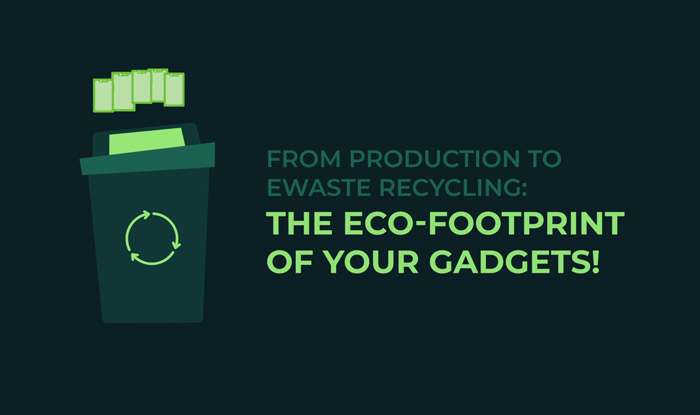From Production to e-Waste Recycling: The Eco-Footprint of Your Gadgets!

When you decide to live sustainably, one of the first decisions you make is to ensure you’re not adding to the problem. One way to do that is to arm yourself with knowledge. Knowing stuff like how much water goes into making your cell phone.
Nearly 13 tons.
How many metals are used to make one smartphone?
62 metals, and all of them irreplaceable.
Can we recover some of these precious raw materials when we recycle our e-waste?
Most definitely.
How much do you think?
According to the report by the UN Environmental Program, we can typically find 100x more gold in every tonne of e-waste than we could ever obtain from a tonne of actual gold ore.
Every year, we generate millions of metric tons of e-waste, recycling only a fraction of it. This complete disregard for environmental health and the earth’s finite resources has resulted in a loss of $57 billion to the world’s economy. It has also severely diminished the earth’s capacity to regenerate its resources. At the pace we’re going, experts warn, we’re going to need the equivalent of 1.7 Earths to fulfill our consumption needs.
While this ecological impact is catastrophic, let us not forget the purely human cost of this relentless obsession with the latest gadgets. In many parts of the world, the raw materials needed to manufacture most tech devices are extracted in a way that heightens regional conflicts and causes grave human rights abuses, violence against children, forced child labor, and other great evils.
Manufacturing is also the phase that’s the most contaminating to the earth. 80% of a digital gadget’s carbon footprint is created at the manufacturing stage. The usage phase is also detrimental but in a specific way. The way our tech devices are created, they are built with a planned end date in mind. After this date, no matter how careful you were with your device, one or more of its components will show signs of wearing — usually battery or storage — forcing consumers to buy newer devices.
Even if you recycle the discarded tech, it comes with its own set of challenges, the least of which is easy access to responsible and ethical recycling services.
So when you are thinking about the ecological footprint of your next tech purchase, keep these extreme figures in mind before you place your order or swipe your card.
To ensure you are doing your job of reducing e-waste in the world, make residential e-waste recycling and commercial e-waste recycling central to your living.
About The Author Kelly Sampson
Kelly Sampson is a writer, blogger, and environmental enthusiast. She has strong opinions about climate change, the dogs vs. cats debate, and Oxford commas. She has lent Hummingbird International her engaging and spirited voice and turned our blog into a great place to find valuable information about e-waste, e-waste recycling, and the ITAD industry. Explore our blog to read more of her work.
